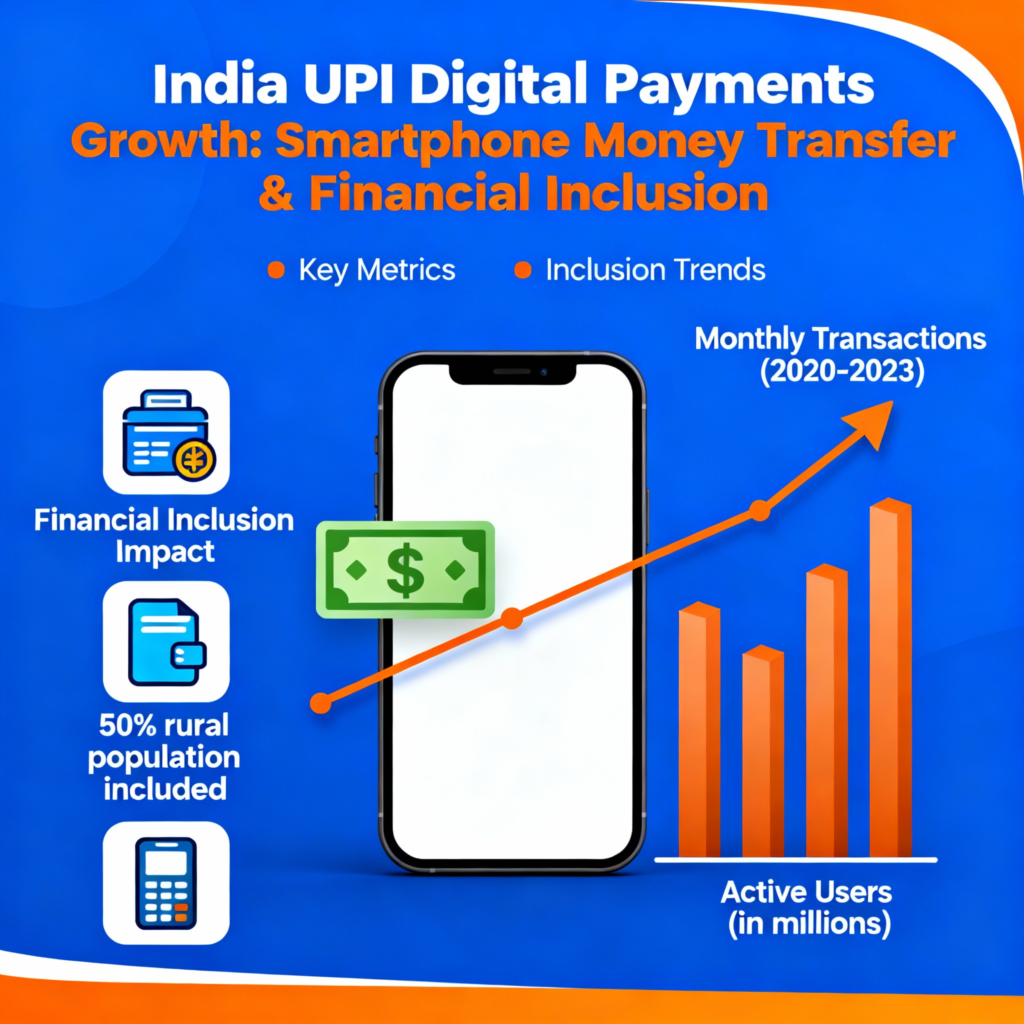Key Highlights
- The Resilience Paradox: Despite 75% account ownership in developing countries, only 56% can access emergency funds within 30 days
- Regional Disparities: East Asia Pacific achieves 78% emergency fund access versus South Asia’s mere 31%, despite similar account penetration
- India’s Digital Revolution: UPI transactions surged to over 1,946 crore monthly, transforming payment infrastructure but gaps remain in meaningful usage
- Usage Dividend: Digital payments in East Asia reach 80% compared to 55% in South Asia, creating vastly different resilience outcomes
- Policy Imperative: Moving from account-focused to outcome-driven metrics essential for bridging inclusion-resilience gap
Understanding the Financial Inclusion-Resilience Gap
The global financial inclusion story appears triumphant at first glance. Low and middle-income countries have witnessed account ownership nearly double from 42% in 2011 to 75% in 2025. This remarkable achievement represents hundreds of millions gaining their first formal financial foothold.
Yet beneath this impressive headline lies a troubling reality that demands immediate attention from policymakers and development practitioners: financial resilience remains stubbornly stagnant. The Global Findex Database 2025 reveals that only 56% of adults in developing economies can access emergency funds within 30 days, a figure unchanged since 2021 despite massive increases in account penetration.
This persistent gap between access to financial services and actual resilience exposes a fundamental truth that challenges conventional thinking about financial inclusion: having a bank account and having financial security are dramatically different things.
The Regional Resilience Divide: East Asia vs South Asia

The most striking evidence of this inclusion-resilience paradox emerges from comparing regional performance. East Asia Pacific (EAP) and South Asia (SA) have achieved remarkably similar account ownership rates at 83% and 78% respectively. However, their resilience outcomes tell a completely different story.
In East Asia Pacific, 78% of adults can access emergency funds within 30 days when crises strike. South Asia manages only 31% – less than half the rate despite nearly identical account penetration. This stark contrast demolishes the assumption that account access automatically translates to financial security.
What explains this dramatic difference? The answer lies in how people actually use financial services rather than merely possessing them. East Asian adults engage with a broader, deeper ecosystem of financial products that create multiple pathways to emergency funds.
The Usage Dividend: Services That Build Real Resilience
Digital Payments as Financial Lifelines
Digital payment infrastructure serves as the backbone of financial resilience. When emergencies strike, family and friends remain the most common support source – but digital systems determine how quickly and reliably that help flows.
East Asia Pacific leads globally with 80% of adults making or receiving digital payments, compared to just 55% in South Asia. This infrastructure advantage transforms social networks from potential support systems into reliable financial safety nets.
India’s UPI revolution exemplifies this transformation. UPI transactions reached over 1,946 crore monthly by July 2025, with rural penetration exceeding 55%. Yet the usage gap between regions suggests India must focus intensively on meaningful engagement rather than merely expanding access. pib
Insurance: The Critical Protection Gap
Insurance represents perhaps the starkest regional divide in financial resilience. While 41% of East Asian adults pay insurers, only 9% of South Asian adults maintain insurance coverage. This massive protection gap leaves hundreds of millions vulnerable to shocks.
In India, insurance payments via UPI rose 34% in health insurance and 25% in term insurance during fiscal 2025. However, the low baseline coverage rates indicate enormous potential for expansion, particularly in rural areas where climate and health shocks pose constant threats.

Strategic Emergency Borrowing
Access to formal credit during emergencies marks another critical resilience factor. East Asia Pacific maintains the highest level of formal borrowing, while South Asia shows the lowest formal borrowing rates. Most emergency borrowing in India’s region still relies on informal loans, which often carry punitive terms and perpetuate debt cycles.
The contrast is particularly stark in emergency borrowing patterns. East Asia Pacific is the only region where most emergency borrowing happens through formal channels, providing predictable terms and consumer protections that informal lending lacks.
The Savings Accessibility Challenge
Perhaps the most important insight concerns savings accessibility. While 40% of developing economy adults saved formally in 2024 (up from 24% in 2021), the ability to access those savings when needed varies dramatically across regions.
In East Asia Pacific, 32% of adults can draw on savings during emergencies, compared to just 8% in South Asia. This suggests that liquid, accessible savings products matter far more than overall savings rates. Traditional savings instruments that lock funds away or impose withdrawal penalties may boost inclusion statistics while actually reducing resilience.
India’s Financial Inclusion Journey: Achievements and Gaps
The Jan Dhan Revolution
India’s Pradhan Mantri Jan Dhan Yojana represents the world’s largest financial inclusion initiative. By August 2025, over 56.04 crore accounts had been opened, with 55% held by women. Total deposits reached ₹2.64 lakh crore, demonstrating meaningful engagement beyond mere account opening.
The program’s success extends beyond numbers. Rural and semi-urban areas account for 67% of beneficiaries, indicating genuine reach to previously excluded populations. The integration with Direct Benefit Transfer (DBT) has facilitated over ₹45.70 lakh crore in direct government payments, proving the accounts’ utility for real financial needs. ibef
UPI: The Digital Payments Game-Changer
India’s Unified Payments Interface has transformed the digital payments landscape with unprecedented speed and scale. Daily transaction values rose from ₹75,743 crore in January 2025 to ₹90,446 crore by August 2025. The platform now processes over 675 million daily transactions, making it central to India’s financial infrastructure.
UPI’s impact on insurance payments particularly demonstrates its resilience potential. Investment-cum-insurance products saw UPI usage grow by 45%, while health insurance UPI payments rose 34%. This indicates growing comfort with using digital infrastructure for long-term financial protection, not just daily transactions.
Persistent Challenges
Despite remarkable progress, significant gaps remain in translating inclusion to resilience. India shows the world’s highest account inactivity rates, with almost one-third of women (32%) maintaining dormant accounts. This inactivity rate, 9 percentage points higher than for men, suggests access without meaningful engagement.
The Reserve Bank of India’s Financial Inclusion Index reached 67 in 2025, up 24.3% since 2021, indicating steady progress. However, the regional comparison with East Asia Pacific suggests India must accelerate efforts to convert access into active usage and resilience outcomes.
Policy Pathways: From Access to Resilience
Prioritizing Active Usage Over Account Numbers
India’s policymakers must shift focus from account opening to active product usage. This requires designing financial services that integrate seamlessly with daily financial activities rather than existing as standalone products. The success of UPI demonstrates how infrastructure that solves real problems drives organic adoption and meaningful usage.
Regulatory frameworks should incentivize banks and financial service providers to focus on engagement metrics rather than merely opening new accounts. Customer onboarding processes must emphasize practical utility and regular usage patterns that build financial habits.
Building Accessible, Flexible Savings Products
Traditional savings products often prioritize growth over accessibility, creating barriers during emergencies. India needs savings instruments that balance wealth accumulation with emergency liquidity. This includes reducing withdrawal fees, simplifying access procedures, and offering partial withdrawal options without penalties.
The success of women-focused savings solutions shows promise. Bank of Baroda’s women customers who accessed enhanced savings products were 57% more likely to maintain PMJDY account balances. At Ujjivan, 58% of women could access emergency funds within seven days compared to 48% of control groups.

Strengthening Social Networks Through Digital Infrastructure
Rather than replacing informal support systems, digital payments should enhance them. Family-based support networks remain crucial for financial resilience, but digital infrastructure determines their effectiveness. Policy should focus on making peer-to-peer transfers more reliable, faster, and accessible.
UPI’s success in facilitating social transfers demonstrates this potential. The platform’s rural penetration above 55% indicates growing capacity to strengthen traditional support networks through modern infrastructure.
Expanding Insurance and Formal Credit Access
Insurance penetration remains critically low across India, leaving millions vulnerable to health, climate, and economic shocks. Policymakers should prioritize micro-insurance products integrated with existing financial services. The growth in UPI-based insurance payments suggests digital infrastructure can overcome traditional distribution barriers.
Formal credit access for emergencies requires innovative risk assessment models that serve previously excluded populations. Digital lending platforms using alternative data sources show promise, with the sector projected to grow from $38.2 billion in 2021 to nearly $515 billion by 2030.
Outcome-Focused Measurement
Moving beyond account ownership metrics, India must track actual resilience outcomes including speed and reliability of emergency funding, overall financial health scores, and crisis response capabilities. The integration of resilience metrics into national financial inclusion strategies represents essential progress.
Partnership with organizations like CGAP for pilot programs testing resilience-oriented products can provide evidence-based policy guidance. These partnerships should focus on measuring real-world financial stress responses rather than theoretical access capabilities.
Development and Governance Implications
Financial Inclusion as Development Strategy
India’s financial inclusion journey illustrates the complexity of translating policy intentions into ground-level outcomes. The Jan Dhan-Aadhaar-Mobile (JAM) trinity represents innovative policy architecture, yet implementation challenges reveal the gap between access and empowerment.
The regional comparison with East Asia Pacific highlights how similar policy inputs can yield vastly different outcomes based on ecosystem development, regulatory frameworks, and usage patterns. This case study demonstrates why development practitioners must focus on outcome measurement rather than input tracking.
Governance and Public Policy
The transition from financial inclusion to financial resilience requires sophisticated governance mechanisms that balance innovation with consumer protection. Policymakers must navigate multiple stakeholder interests while ensuring that expanded access genuinely improves citizens’ economic security.
Regulatory sandboxes, pilot programs, and evidence-based policy iteration become essential tools for managing this transition. The success of UPI demonstrates how appropriate regulatory frameworks can unleash innovation while maintaining system stability.
Economic Security and Social Justice
Financial resilience connects directly to broader social justice objectives. The concentration of financial vulnerability among women, rural populations, and marginalized communities means that resilience gaps perpetuate existing inequalities. Addressing these gaps becomes essential for inclusive development.
The evidence from women-focused financial products shows measurable improvements in household financial decision-making and emergency preparedness. This suggests that targeted interventions can simultaneously advance financial resilience and gender empowerment objectives.
The Path Forward: Building Resilient Financial Ecosystems
India stands at a critical juncture in its financial inclusion journey. Having achieved remarkable success in expanding access, the country must now focus intensively on converting that access into genuine financial resilience. This transformation requires moving beyond account ownership metrics to embrace outcome-focused strategies that enable citizens to withstand financial shocks effectively.
The comparison with East Asia Pacific provides both sobering perspective and actionable guidance. Similar account penetration rates can yield vastly different resilience outcomes based on how financial services are designed, delivered, and utilized. India’s path to inclusive development and economic security depends on bridging this critical gap between access and resilience.









+ There are no comments
Add yours